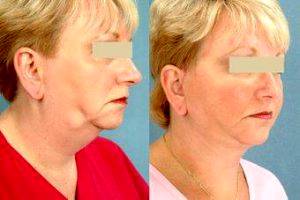Smartlipo MPX Before And After Photos
Take a look at our SmartLipo MPX before and after pictures. See the results of SmartLipo MPX from various plastic surgeons.
SmartLipo MPX with temperature control is superior
The newer version of SmartLipo is certainly superior to the earlier generations. The newer SmartLipo MPX system is better both for fat removal and skin tightening.
The Thermaguide system in the newer system has a built in temperature monitor that controls the temperature of the laser to avoid the possiblilty of burns from the laser. (Arnold S. Breitbart, MD, FACS, Long Island Plastic Surgeon)
New Smartlipo has its advantages
The key to laser lipolysis (smartlipo) is to accurately and evenly heat the tissue to a predetermined temperature to stimulate collagen production and remodeling.
The newer generation smartlipo machines have “thermaguide” which is a temperature sensor at the tip of the laser which very accurately determines the tissue temperature in real time.
This helps to remove guess work and measuring errors. Even tissue heating stimulates collagen remodeling and production which leads to improved skin contraction versus conventional liposuction. Too little heating of the tissue has insufficient effect and is no better than traditional liposuction.
Too much heating of the tissue has potentially serious side effects and should be avoided. The new “thermaguide” temperature sensor help physicians more evenly and consistently reach the target tissue temperature in order to deliver the optimum treatment outcomes. (Richard H. Fryer, MD, Salt Lake City Plastic Surgeon)
Smart Lipo MPX is better
The MPX is far better than the older versions which were used for 7 years outside the USA. The MPX is design by Cynosure and adds many improvement that are important in safety and results. Now you can rad about the TPX which is even better (Barry E. DiBernardo, MD, Montclair Plastic Surgeon)
SmartLipo has changed. Temperature control is the secret.
The first two or three generations of SmartLipo (depending on how you are counting) were not effective. Today with temperature controlled shrinkage of the subdermal layer the results are better in the patients who need skin shrinkage.(Not all patients do)
Our present routine is to use it only on patients who need skin shrinkage due to stretch marks and loss of elasticity.
Most patients with good skin can be saved the additional expense and time of Smart Lipo and get an equivilent result. (Nathan Mayl, MD (retired), Fort Lauderdale Plastic Surgeon)
What happens to the fat after Smart Lipo treatment?
Some doctors were advocating not suctioning the fat after Smart Lipo. The body will resorb the lasered fat with the help of macrophages, which are scavengers of foreign bodies. The problem is that it creates a great deal of swelling and takes much longer to get the final result.
It is also hard to be accurate. I always perform traditional liposculpture along with Smart Lipo. This is more precise and more efficient. (Kenneth L. Stein, MD, Chicago Plastic Surgeon)
Fat must be aspirated away before or after the laser part of the smartlipo procedure. Fat which is not aspirated may return or cause increased inflammation and possible scarring. (Edward Lack, MD, Chicago Dermatologist)
With energy assisted liposuction procedures – SmartLipo MPX (laser), Vaser lipo (ultrasound), etc. – the energy source imparts energy into the fat cells causing them to rupture and liquify.
If the area or volume is small the body can mobilize and resorb this liquified fat though the normal healing process.
If the volume of fat is moderate to large then most plastic surgeons will remove the liquified fat with traditional liposuction. Removing the liquified fat will help decrease post operative swelling and help speed the healing process. (Vincent D. Lepore, MD, San Jose Plastic Surgeon)
Anesthesia for SmartLipo
In general, anesthesia options for SmartLipo, as with traditional liposuction, include local anesthesia, sedation anesthesia, or general anesthesia.
For limited areas, or for a patient that doesn’t mind the discomfort of the local anesthesia, local anesthesia alone, perhaps with an oral dose of Valium, is adequate.
For more extensive areas (and yours is bordering on this), sedation anesthesia is more comfortable for the patient. In addition to the local anesthesia, an anesthesiologist puts an IV in and gives sedation anesthesia (like for a colonoscopy), so the patient can’t feel or remember the procedure.
Full general anesthesia not usually indicated for liposuction. (Arnold S. Breitbart, MD, FACS, Long Island Plastic Surgeon)
SMARTLIPO MPX Anesthesia: General or Local-Sedation
SMARTLIPO MPX treatments can be performed under both General and Local-Sedation anesthesia. The number and volume of the areas to be treated and each individual patients response to anesthetic agents determines the best choice. If a patient fears General Anesthesia and 3 or less small area need to be treated, SMARTLIPO MPX can be used under Local-Sedation Anesthesia.
If a patient has had a history of previous dental or skin surgery under Local Anesthesia that did not provide adequate “numbing,” or a larger number of sites/ volume of treatment areas, or previous liposuction with extensive scarring, a General Anesthetic may be the best choice.
A well informed patient with the assistance of her/his Plastic Surgeon makes the decision of the Anesthesia method of choice. (Christopher D. Prevel, MD, Orlando Plastic Surgeon)
General anesthesia is not worth the risk with SmartLipo MPX
General anesthesia should never be used with any type of liposuction. I have performed liposuction since 1995 and have done every case with local (tumescent) anesthesia. I use ProLipo (same wavelengths as SmartLipo) as well as SlimLipo for laser-assisted liposuction.
Proper tumescent anesthesia should provide excellent comfort. Usually any discomfort is handled simply by adding a little more local anesthetic to the specific area. Many patients request a mild sedative before the procedure; generally 10 mg of Valium by mouth is sufficient.
General anesthesia carries significant risks and is required for many invasive surgical procedures, but is absolutely not required for and not worth the risk for a cosmetic procedure such as liposuction. (Robert C. Langdon, MD, Guilford Dermatologic Surgeon)

